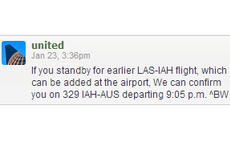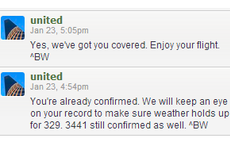Getting Social Customer Experience Right
A look at how three brands are encouraging positive, socialized conversations that are aligned with business objectives and a desire to grow brand value but creating customer advocates.
A look at how three brands are encouraging positive, socialized conversations that are aligned with business objectives and a desire to grow brand value but creating customer advocates.
I was struck recently by three interactions, each of which resulted in an exceptional customer experience in the context of the social Web. A large retailer, an airline, and a fashion and design shop, all taking a different approach toward the same end: encouraging positive, socialized conversations aligned with business objectives and a desire to grow brand value by creating customer advocates.
The first, and perhaps the most dramatic, was CVS’ decision to discontinue the sale of tobacco products in its stores. As a U.S.-based nationwide chain of pharmacies, there’s been a longstanding conversation about the inherent contradiction as a center for health and a retail seller of tobacco. It was a bit like a tire shop that also sold nails, and the conversations noting this conflict were both predicable and widespread, at a level of a sort of uniform background noise. Then came this announcement: Suddenly, people in my social circles who don’t normally talk with each other (I make it a point to follow lots of different people) were talking about the same thing.
When one sees a spontaneous rise in a specific topic across demographic and interest groups, the conclusion is that “this must be something to pay attention to.” In the same breath, it also (generally) means “this must be something to share.” And that is exactly what people were doing via the social Web.
But it didn’t stop there: More than sharing, people were adding their own voice. The most common added thought was, “As a result of this decision, I will shop (more) at CVS.” I saw this expressed on Facebook and Twitter of course, and also in mainstream media: I happened to be in London, where the BBC did a feature opinion piece speculating on the motives, and asking the question, “Does it matter why a firm takes a specific course of action so long as the action is clearly for the great good?” The conversation clearly went well beyond the initial announcement, and CVS is at this stage the early recipient of positive word of mouth. You can see the CVS page from Facebook in the figure here:

The second case involves an airline. Our firm, Lithium Technologies, had a conference two weeks back. Near the end of the multiday conference, the weather was (again) turning for the worse and flight disruptions started popping up in conversation. After receiving a notice of possible disruption, I posted to United Airlines using Twitter shortly after lunch: my flight was due to leave at 7 p.m. and arrive in Austin at 11 p.m. You can see my first post here:
 About 20 minutes later I received a post back from United saying that “If [I] could make the 5p flight, where I was now listed for standby, I could be home via the 9p.” Otherwise, it was likely I would not be home until late the next day. What’s remarkable about this is that I did not to have to ask for a specific flight, nor was the response designed to “get me home.” The response showed a clear effort on the part of United to understand what I wanted, and how we could work together to get that done. You can see that response here:
About 20 minutes later I received a post back from United saying that “If [I] could make the 5p flight, where I was now listed for standby, I could be home via the 9p.” Otherwise, it was likely I would not be home until late the next day. What’s remarkable about this is that I did not to have to ask for a specific flight, nor was the response designed to “get me home.” The response showed a clear effort on the part of United to understand what I wanted, and how we could work together to get that done. You can see that response here:
 As a business, if you ever want to create a brand advocate, do this: In a time of crisis, join hands with your customers and develop a solution together. Guaranteed advocate.
As a business, if you ever want to create a brand advocate, do this: In a time of crisis, join hands with your customers and develop a solution together. Guaranteed advocate.
So, I went to the airport and waited to see if I would be able to board. Note that I already made a decision to trust United: I could have stayed on in the hotel another day and then flown home. But I wanted to see my family and I believed that by working with United I would be able to do that. Here’s where customer loyalty also helped me out: I select United whenever I have the choice, and as a result have reasonable (but not the absolute highest) status. That made the difference: I got one of the last seats on the plane. I posted back to United, confirming that I was on the 5 p.m. to Houston. The social team in Chicago went to work on the connecting flight while I was en route.
When I landed in Houston, I had a couple of posts waiting. You can see them here:
 Again, status (customer loyalty) came into play. I was listed number one for standby, and made the 9 p.m. from Houston to Austin, arriving home about an hour before my original flight. Of note, I arrived on the last flight that would land in Austin – we had ice and snow – for the next 24 hours. Here was my final post:
Again, status (customer loyalty) came into play. I was listed number one for standby, and made the 9 p.m. from Houston to Austin, arriving home about an hour before my original flight. Of note, I arrived on the last flight that would land in Austin – we had ice and snow – for the next 24 hours. Here was my final post:

Now ask yourself, “On a scale of zero to 10, how likely do you think I am to recommend United?” This is what a great social customer care team, combined with a business strategy that is focused on safe, customer-oriented operation, can accomplish. Does your business generate advocates like this? If it does that’s great. If not, ask, “Why not?” and then connect up your business objectives and the expected benefits, if any (and there generally are benefits), and develop a plan to start building and measuring them.
In the final example, and just in case you’re thinking, “Great, but I have a smaller business that operates on a more local level,” consider my experience at Bolongaro Trevor, an independent fashion and design shop in London. Walking past, I was intrigued by what I saw and stepped in to the store. I was immediately greeted by a professional, friendly team that really knew about the business: I learned about the founders (the designers who created AllSaints) and their current endeavor Bolongaro Trevor, about its values, and what it stood for. Now, stop right there: If you are in retail, or if you have customer-facing employees, could they tell this story to a customer? When I was at Progressive Insurance I learned the value of ensuring that every employee knew what the company did, why, the company values, and how we were measured. It’s pure power.
I looked at a few items and bought a jacket for my wife. I then went back later and bought a jacket for my son. The next day, and feeling a bit left out, I looked online and saw one of their shirts that I really wanted. Trouble is, I have long arms: “L” fits my waist, “XL” fits my arms. So I posted to the shop on Twitter, and received a prompt response back:

My shirts are waiting; I’ll be back in London next week, and will try the two sizes and purchase the one that fits. Again, as a result of a focus on care, I’m now a customer. And again, ask yourself: “On a scale of zero to 10, how likely is Dave to recommend Bolongaro Trevor?” I’ll give you hint: I’ve already sent an email to a colleague who asked me where to buy clothes in London.
So there you have it: big retail and tough choices, airline and customer care, and an independent shop with a winning front-line team, each with a basic commitment to its customers that results in the building of a powerful brand. Each of these real-world examples are within reach of a well-run social customer care team. Your turn!